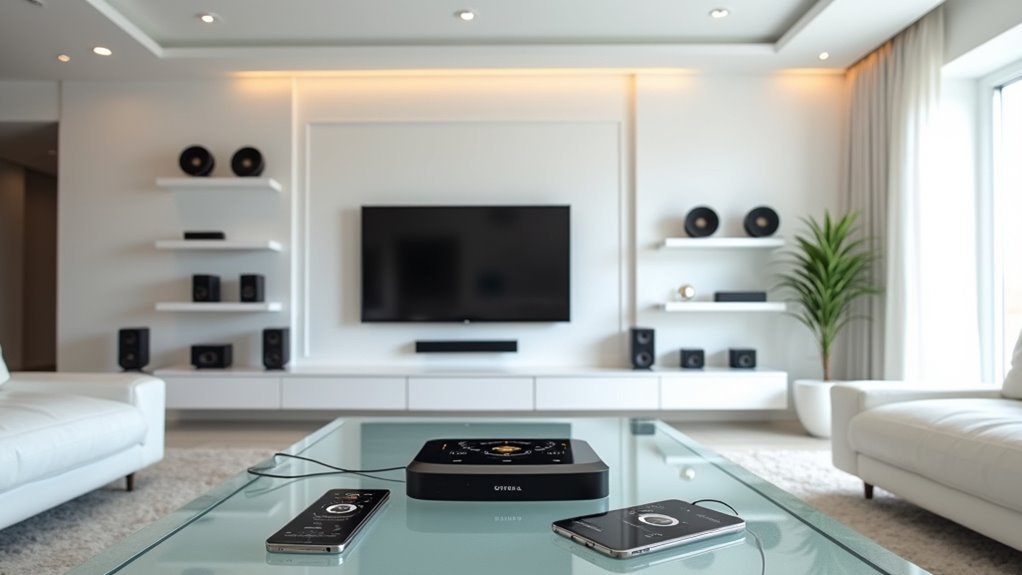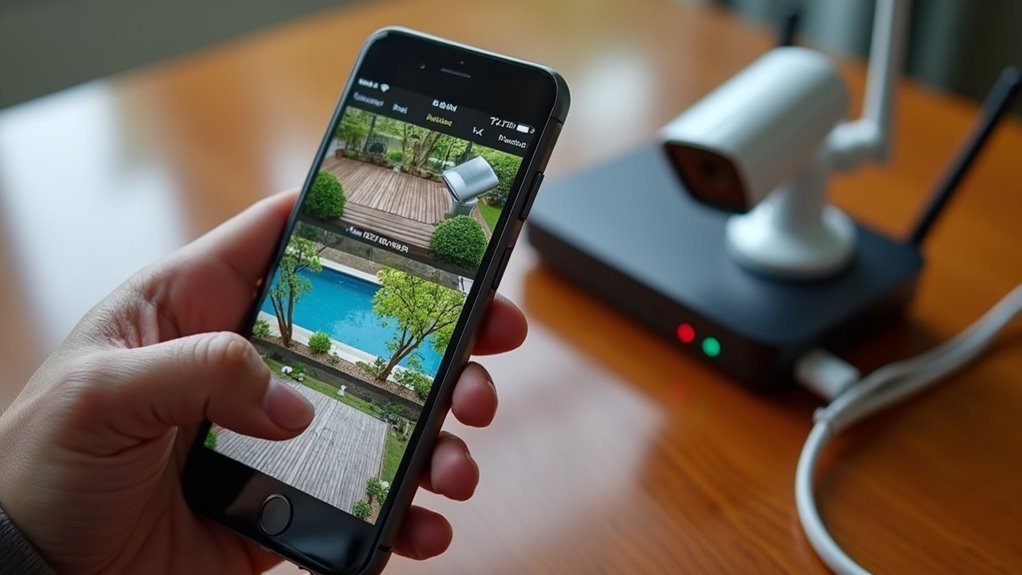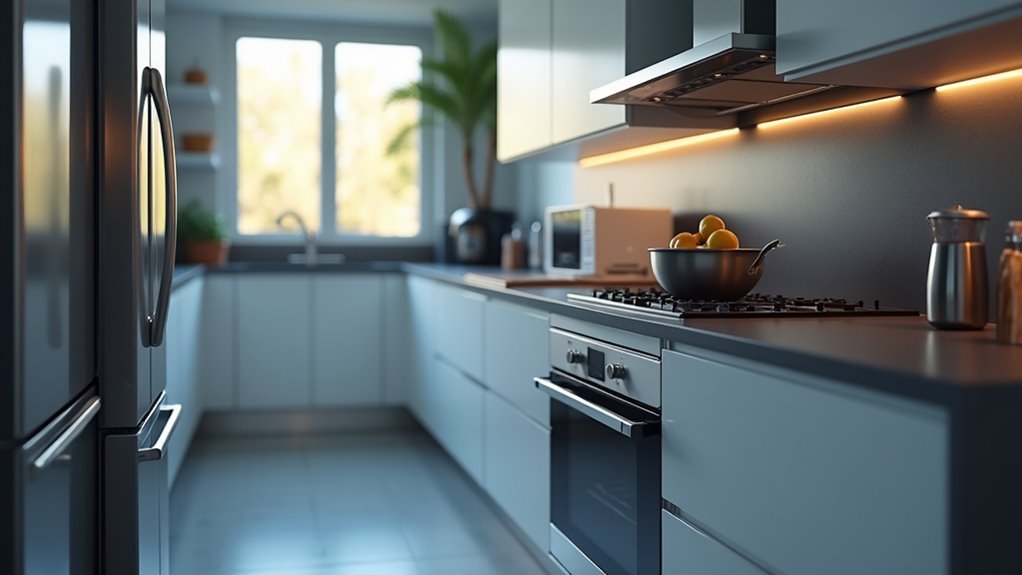You’ve probably wondered why your music has to stop when you move from the living room to the kitchen, or why you can’t sync audio throughout your entire home without depending on spotty internet connections. Local multi-room audio systems solve this frustration by creating a dedicated network within your house that connects wireless speakers across every room. What you might not realize is how simple it’s become to build this setup yourself.
Understanding Local Multi-Room Audio Systems

When you’re looking to enjoy music throughout your entire home without the hassle of multiple streaming services or complicated setups, local multi-room audio systems offer an elegant solution.
These systems connect wireless speakers across different rooms using your existing network infrastructure, creating synchronized audio zones throughout your property.
You’ll operate everything through a dedicated control app that lets you manage playback across multiple zones effortlessly.
Whether you want the same playlist flowing through every room or prefer different audio sources in each space, multi-room sound systems provide that flexibility.
The setup typically involves placing speakers in your desired locations, choosing between standalone wireless units or integrated in-wall installations based on your preferences and room layouts.
How Local Multi-Room Audio Works Without Internet
You can enjoy multi-room audio throughout your home without any internet connection by leveraging your local network infrastructure.
Your system distributes audio offline through dedicated wired connections or a local Wi-Fi network that operates independently from your internet service.
The hardware connection methods guarantee your speakers communicate directly with each other, creating synchronized playback across all rooms.
Local Network Infrastructure
While internet-based streaming services dominate today’s audio landscape, local multi-room audio systems operate independently through your home’s network infrastructure. Your local network serves as the backbone, connecting audio devices through Wi-Fi, Ethernet, or Bluetooth protocols. This setup doesn’t require external internet access to function effectively.
At the heart of your multi-room audio system lies a central hub or controller that manages audio distribution across different zones. This controller coordinates synchronized playback between speakers throughout your home, ensuring seamless audio delivery.
Your network infrastructure transmits high-quality audio signals directly between devices, eliminating dependence on streaming services or internet bandwidth. You’ll benefit from enhanced reliability since your system won’t suffer from internet outages or connection slowdowns.
This local approach provides consistent performance and gives you complete control over your audio experience.
Offline Audio Distribution
Building on this network foundation, offline audio distribution transforms your local infrastructure into a completely self-sufficient entertainment system.
Your multi-room audio speakers communicate directly through your WiFi network using protocols like DLNA or AirPlay, eliminating any dependency on internet connectivity. You’ll access your personal library of local music stored on devices like NAS systems or media servers, creating customized playlists without streaming services.
The central hub distributes audio files seamlessly across connected speakers throughout your home. You maintain complete control over synchronized playbook and individual room settings, even when your internet goes down.
This offline audio distribution guarantees uninterrupted entertainment, allowing you to enjoy your private media collection with full multi-room functionality regardless of external connectivity issues.
Hardware Connection Methods
Three primary hardware connection methods enable local multi-room audio systems to operate independently of internet connectivity. You can choose wired or wireless solutions based on your specific needs and home layout.
Wired systems involve running speaker cables from a central amplifier or AV receiver to each room’s speakers. This method delivers stable, high-quality audio playback across your entire home network. You’ll enjoy consistent performance without signal interference or range limitations.
Wireless options like Bluetooth offer quick setup for local audio systems, though they may restrict the number of connected speakers and operating range. Protocols such as AirPlay or DLNA facilitate device communication without internet dependency.
Your AV receiver acts as the central hub, distributing multiple audio sources to various zones seamlessly.
Key Components for Building a Local System
Once you understand the fundamentals of local multi-room audio, you’ll need several essential components to build an effective system.
Your speakers form the foundation—choose from soundbars, in-wall speakers, or standalone units depending on your room layout and aesthetic preferences.
You’ll also need audio components like an AV receiver or amplifier to manage distribution across rooms and guarantee synchronized playback.
A control device, typically your smartphone or tablet, serves as your command center for managing the entire system.
While wireless systems offer easier installation and greater flexibility, you might need additional hardware like network audio players or dedicated streaming devices to access high-resolution content effectively.
Smart device integration with voice assistants can further enhance your system’s functionality.
Wireless Vs Wired Local Audio Networks

How should you connect your multi-room audio system?
You’ll need to choose between wireless audio and wired systems, each offering distinct advantages for your multi-room setups.
Wireless audio networks use Wi-Fi or Bluetooth technology, providing easier installation and flexible speaker placement. You can quickly expand or reconfigure your system without extensive rewiring, making wireless solutions more affordable upfront since they eliminate cabling costs.
Wired systems deliver superior sound quality and reliability through stable direct connections with reduced interference. They’re ideal for dedicated listening environments and larger installations, though they typically require higher initial investments for materials and professional installation.
Both options effectively support audio distribution throughout your home. Your choice ultimately depends on whether you prioritize sound quality and reliability or prefer installation flexibility and lower upfront costs.
Setting Up Your Home Network Infrastructure
You’ll need to verify your network can handle the bandwidth demands of streaming high-quality audio to multiple rooms simultaneously.
Your router’s placement becomes critical—positioning it centrally in your home reduces signal interference and provides consistent coverage throughout all speaker locations.
These two factors work together to create the foundation for reliable multi-room audio performance.
Network Speed Requirements
When setting up a local multi-room audio system, your network’s speed and stability directly determine whether you’ll enjoy seamless music throughout your home or frustrating dropouts that kill the mood. Understanding network speed requirements guarantees peak performance across all connected speakers.
For smooth streaming audio, you’ll need at least 5 Mbps per speaker. Here’s what different setups require:
| Number of Speakers | Minimum Speed Required |
|---|---|
| 2-4 speakers | 10-20 Mbps |
| 5-8 speakers | 25-40 Mbps |
| 9+ speakers | 45+ Mbps |
Your Wi-Fi network should support dual-band frequencies, with 5 GHz providing faster speeds and less interference. For stationary devices like AV receivers, consider wired Ethernet connections to minimize latency. Regularly test your network speed to identify potential issues before they affect your multi-room audio performance.
Router Placement Strategy
Three critical factors determine whether your router placement will make or break your multi-room audio experience: location, elevation, and signal distribution.
Position your router centrally in your home to guarantee even Wi-Fi coverage throughout all rooms where you’ll stream audio.
Elevate your router off the ground by placing it on a shelf or wall-mounting it. This simple adjustment considerably improves signal strength and reduces interference from furniture and appliances.
For ideal performance, implement these router placement strategies:
- Use a dual-band router to separate audio streaming (5GHz) from other devices (2.4GHz)
- Install Wi-Fi extenders or mesh systems in larger homes
- Minimize obstructions between router and audio devices
- Update firmware regularly for enhanced security and performance
Speaker Placement and Zone Configuration

Strategic speaker placement forms the backbone of any successful multi-room audio system, directly impacting both sound quality and coverage throughout your home. You’ll want to configure zones based on your home’s layout and usage patterns for ideal audio distribution.
| Zone Type | Speaker Recommendation |
|---|---|
| Entertainment Areas | Floor-standing or bookshelf speakers |
| Kitchen/Bathrooms | In-ceiling moisture-resistant speakers |
| Bedrooms | In-wall speakers for space-saving |
| Outdoor Spaces | Weather-resistant outdoor speakers |
| Quiet Areas | Smaller, discrete speakers |
In-wall and in-ceiling speakers offer discreet installation while maintaining your room’s aesthetic. Group speakers by function rather than location – entertainment zones need different audio characteristics than quiet spaces. Proper calibration guarantees balanced sound levels across all zones, creating an immersive experience tailored to each area’s specific needs.
Control Methods for Offline Audio Distribution
Once you’ve positioned your speakers strategically, you’ll need reliable control methods that don’t depend on internet connectivity to manage your multi-room audio system effectively.
Offline distribution systems offer multiple control options that operate independently from cloud services.
Your control choices include:
- Dedicated hardware remotes – Physical controllers for direct system access
- Wall-mounted touch panels – Fixed control points in convenient locations
- Local network apps – Smartphone applications connecting directly to your system
- Direct device protocols – AirPlay and Bluetooth for immediate streaming
These offline control methods let you manage speaker grouping, adjust individual room volumes, and assign different audio sources across zones.
You can simultaneously control multiple speakers or customize each room’s audio independently. Local media servers also enable streaming from personal devices, giving you complete distribution control without external service dependencies.
Compatible Audio Sources and File Formats
Your multi-room audio system’s versatility depends heavily on the audio sources and file formats it can handle. You’ll find these systems support numerous streaming services like Spotify, TIDAL, and Apple Music directly through control apps. For personal collections, you can access music stored on local servers or NAS devices throughout your home.
| Source Type | Examples | Benefits |
|---|---|---|
| Streaming Services | Spotify, TIDAL, Apple Music | Vast libraries, convenience |
| Local Storage | NAS devices, home servers | Private collections, offline access |
| Physical Media | Networked CD players | Legacy collection integration |
| High-Resolution Audio | FLAC, DSD, ALAC files | Superior sound quality |
Common file formats include MP3, WAV, FLAC, and AAC, with many systems supporting high-resolution audio formats for audiophiles demanding premium sound quality.
Benefits of Keeping Audio Local
When you keep your audio local in a multi-room system, you’ll gain significant privacy protection since your personal music libraries and listening habits aren’t transmitted over the internet.
You’ll also reduce your dependency on network connectivity, ensuring your music continues playing even when your internet connection fails or slows down.
These benefits make local audio systems particularly appealing if you value both data security and reliable performance.
Enhanced Privacy Protection
While cloud-based audio services have become increasingly popular, they’ve also introduced significant privacy concerns that many homeowners don’t fully consider.
Local multi-room audio systems offer superior privacy protection by keeping your data within your home network’s boundaries.
Enhanced privacy protection through local systems includes:
- No external tracking – Your listening habits aren’t monitored by service providers
- Customizable privacy settings – You control which devices access your content
- Reduced internet dependency – Less connectivity means fewer interception opportunities
- Personal data control – Your information stays on your local devices
With local storage for your music libraries, you’ll maintain complete ownership of your content without exposing it to third-party access or potential data breaches that plague cloud-based services.
Reduced Network Dependency
Since local multi-room audio systems operate independently of your internet connection, you’ll enjoy uninterrupted music playback even during network outages or slowdowns. By utilizing local storage, you’re dramatically reducing network dependency while maintaining consistent audio playback throughout your home.
| Network-Based Audio | Local Multi-Room Audio |
|---|---|
| Requires constant internet | Operates independently |
| Susceptible to outages | Continues during outages |
| Variable streaming quality | Consistent performance |
| Dependent on ISP reliability | Self-sufficient operation |
Your music library remains accessible regardless of external factors. Local systems eliminate buffering delays and connection drops that plague streaming services. You’re guaranteed uninterrupted music even when your internet provider experiences technical difficulties, ensuring your audio experience remains seamless and reliable.
Popular Local Multi-Room Audio Platforms
As you explore local multi-room audio solutions, you’ll discover several platforms that have established themselves as industry leaders through their robust Wi-Fi and Ethernet streaming capabilities.
These systems deliver high-quality streaming media throughout your home without relying on external internet services.
Sonos leads the market with seamless integration across speaker models within its ecosystem. You can easily control multiple zones through their intuitive app while accessing various music streaming services.
Other standout platforms include:
- Bluesound – Offers high-resolution audio streaming with superior sound quality
- Denon HEOS – Provides extensive compatibility with streaming services and local networks
- Mixed-brand systems – Allow flexibility to combine different manufacturers’ devices
- Universal apps – Enable individual room control and customized audio experiences
These local multi-room audio platforms give you complete control over your home’s sound environment.
DIY Installation Steps and Best Practices
Once you’ve selected your preferred multi-room audio platform, proper installation becomes essential for achieving best performance throughout your home.
Start by choosing appropriate speakers for each room, considering size, type, and system compatibility. Verify all wireless speakers connect to the same Wi-Fi network for seamless communication and synchronization across zones.
Speaker selection requires careful consideration of room dimensions, audio preferences, and network connectivity to ensure optimal multi-zone performance.
For wired installation, strategically place speakers and run cables through walls or ceilings to maintain a clean appearance while minimizing interference.
Use your system’s dedicated app or controller to manage audio playback, customize sound settings, and create playlists for each room.
After completing your multi-room installation, test audio quality in every zone and adjust speaker placement as needed to optimize your listening experience throughout the entire system.
Troubleshooting Common Local Network Issues
When your local multi-room audio system starts acting up, you’ll typically encounter three main network-related problems that can disrupt your listening experience.
WiFi signal strength issues can cause speakers to drop in and out, while connectivity problems may prevent certain speakers from staying connected to your network consistently.
App control failures often stem from communication breakdowns between your mobile device and the speakers, leaving you unable to manage playback or adjust settings.
WiFi Signal Strength Problems
Although your local multi-room audio system might work perfectly when you’re near the router, you’ll likely encounter frustrating dropouts and interruptions as you move speakers to different rooms throughout your home.
WiFi signal strength directly impacts your multiroom system’s ability to keep speakers together and deliver seamless audio throughout your house.
Distance and physical obstacles greatly affect signal quality. To optimize your network:
- Check router placement – Position it centrally and away from interference sources
- Use WiFi analysis apps – Identify signal strength and competing networks
- Install WiFi extenders – Boost coverage in weak signal areas
- Update router firmware – Enhance performance and reliability
Walls, furniture, and appliances can block signals, causing frustrating dropouts during playback across zones.
Speaker Connectivity Drops
Beyond signal strength issues, speaker connectivity drops represent one of the most common frustrations you’ll face with local multi-room audio systems.
These interruptions occur when speakers suddenly disconnect during playback, often caused by electronic interference from microwaves or cordless phones disrupting your Wi-Fi signals.
Network overload creates another significant problem—when too many devices compete for bandwidth, your audio streaming suffers.
You’ll experience frequent drops as your system struggles with insufficient network resources.
To maintain network stability, keep all speaker firmware updated to prevent compatibility conflicts.
Consider installing a dedicated wireless hub or mesh Wi-Fi system to expand coverage and reduce connectivity issues.
These solutions provide the robust foundation your multi-room setup needs for consistent, uninterrupted performance throughout your home.
App Control Failures
Why does your multi-room audio app suddenly lose control of your speakers when everything seemed to work perfectly moments before?
App control failures typically stem from connectivity disruptions between your device and speakers. When your app can’t communicate with your audio system, you’ll lose the ability to adjust volume, change tracks, or manage room groupings.
To restore control over your speakers, follow these troubleshooting steps:
- Verify all speakers and devices connect to the same Wi-Fi network
- Check app permissions for network access in your device settings
- Restart both the app and your controlling device completely
- Update firmware for speakers and the app to latest versions
If you’re using wired connections, inspect all cables for secure attachment.
These systematic checks will typically resolve most app control issues.
Expanding Your System Over Time
When you’re ready to enhance your local multi-room audio setup, you’ll find that most systems offer straightforward expansion options that grow with your needs and budget.
You can expand your system by adding compatible wireless speakers or components that integrate seamlessly with your existing setup. This allows you to customize your audio experience by mixing different speaker models and types throughout your home.
Mix and match speaker models throughout your home by adding compatible wireless components that integrate seamlessly with your existing audio setup.
As technology advances, you can upgrade individual components like high-resolution audio players or subwoofers without replacing your entire system.
The expansion process typically involves connecting new devices to your existing Wi-Fi network and managing them through your central control app. Investing in systems supporting open standards like AirPlay or Google Cast simplifies future expansions by allowing diverse brand compatibility.
Professional Vs DIY Installation Considerations
Once you’ve planned your system expansion, you’ll need to decide whether to tackle the installation yourself or hire professionals.
Professional installation guarantees peak performance through expert techniques and customized design support tailored to your home’s acoustics. While DIY installation offers cost savings and flexibility for tech-savvy homeowners, it can lead to setup challenges and connectivity issues.
Consider these key factors when choosing your approach:
- Professional installers provide thorough consultation and ongoing support
- DIY systems offer immediate cost savings but may require troubleshooting skills
- Complex wiring and speaker placement benefit from professional expertise
- Professional installation saves time while guaranteeing seamless integration
Your home audio system’s long-term performance often depends on proper initial setup, making this decision vital for your multi-room audio experience.
Frequently Asked Questions
How Does Multi Room Audio Work?
You’ll connect speakers throughout your home via wired or wireless networks, then use a centralized app to control them. You can group speakers into zones and play synchronized audio across selected rooms or everywhere.
What Is the Best Speaker Setup for Music?
You’ll want a mix of wired and wireless speakers – in-wall units for seamless aesthetics, bookshelf or floor-standing speakers for larger rooms, and portable wireless options for flexibility across your home.
How Can I Listen to Music Throughout My House?
You can set up speakers in multiple rooms connected through wired or wireless networks. Use a smartphone app to control playback, playing identical music everywhere or different selections in each room simultaneously.
What Is the Best Multi-Room Music System?
You’ll find Sonos offers the best overall multi-room system with seamless integration and versatile setup options. For budget-friendly alternatives, consider Amazon Echo or Google Nest systems that provide voice control and streaming convenience.





Leave a Reply